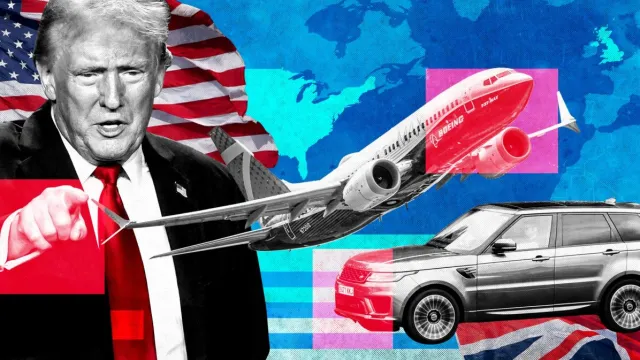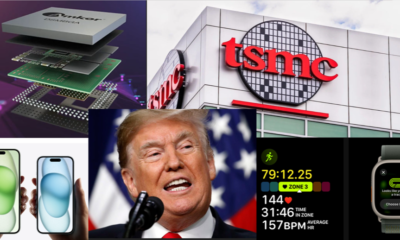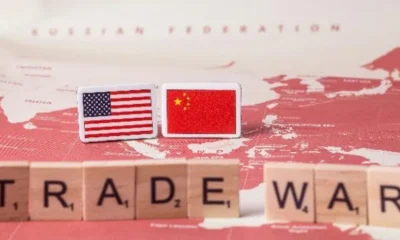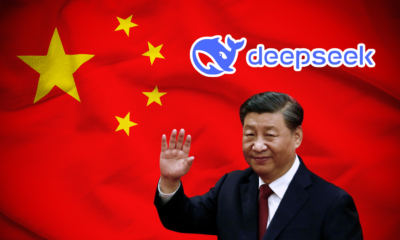Economy
Trade War Alert. How Trump’s New 25% Tariff on Canada, Mexico, And China Could Shake Global Trade?
Published
11 months agoon

In his typical headline-grabbing style, President-elect Donald Trump has fired the first salvo that could ignite a full-blown trade war. On Monday, he pledged steep tariffs on the United States’ three largest trading partners—Canada, Mexico, and China—detailing measures that could upend global trade and raise questions about the future of international agreements.
Trump, who will be sworn in on January 20, 2025, announced plans for a 25% tariff on Canada and Mexico until they address two hot-button issues: the flow of drugs, particularly fentanyl, and illegal border crossings. This bold move seems to defy the principles of the United States-Mexico-Canada Agreement (USMCA), which Trump himself championed during his first term.
A Big Stick Diplomacy With Canada and Mexico
True to his campaign mantra of “putting America first,” Trump declared his intent to impose the tariffs via one of his first executive orders. On Truth Social, he elaborated:
“On January 20th, as one of my many first Executive Orders, I will sign all necessary documents to charge Mexico and Canada a 25% Tariff on ALL products coming into the United States, and its ridiculous Open Borders.”
The timing of this announcement is notable, as illegal crossings at the U.S. border had fallen significantly this year, thanks to stricter border measures under President Biden and increased enforcement by Mexico. Still, with over 83% of Mexico’s exports and 75% of Canada’s exports destined for the U.S., Trump’s tariffs could severely rattle their economies.
While this move ostensibly targets border issues, it risks violating USMCA, the 2020 free-trade pact designed to maintain largely duty-free trade among the three nations. This agreement includes a six-year review clause, with renegotiations due in 2026, but Trump’s threats could accelerate that timeline.
Tariff Talk with Canada
Trump’s tariff rhetoric didn’t stop at announcements. He reportedly had a conversation with Canadian Prime Minister Justin Trudeau about trade and border security. A Canadian source described the exchange as constructive:
“It was a good discussion, and they will stay in touch.”
Whether this indicates a softening of Trump’s stance remains uncertain. Some analysts believe his tariff threats are a strategic gambit to force early renegotiations of USMCA. William Reinsch, a former president of the National Foreign Trade Council, weighed in:
“This strikes me more as a threat than anything else. I guess the idea is if you keep hitting them in the face, eventually they’ll surrender.”
A Heavier Blow to China
Trump didn’t stop at North America. In a pointed jab at China, he proposed an additional 10% tariff on top of existing duties, signaling one of the most aggressive economic stances since his earlier trade battles during his first term.
The impact of this announcement rippled through financial markets. The dollar strengthened, rising 1% against the Canadian dollar and 2% against the Mexican peso. However, the global response was less favorable—Asian share markets dipped, European equity futures fell, and S&P 500 futures saw a 0.3% decline.
More Tariffs in the Pipeline?
This isn’t Trump’s first flirtation with sweeping tariffs. During the election campaign, he floated the idea of blanket tariffs of 10% to 20% on nearly all imports, and in more dramatic moments, suggested levies as high as 200% on cars crossing the U.S.-Mexico border.
If history is any guide, these threats could either lead to significant policy changes or collapse under the weight of global and domestic backlash. The question now is whether Trump’s stick-heavy approach will extract concessions or alienate key allies.
China Reacts With No Winners in a Trade War
In a swift response to U.S. President-elect Donald Trump’s latest trade threats, the Chinese Embassy in Washington delivered a clear message: no one stands to gain from a trade war.
“China believes that China-U.S. economic and trade cooperation is mutually beneficial in nature,” said Liu Pengyu, a spokesperson for the Chinese Embassy, in a statement. “No one will win a trade war or a tariff war.”
Targeting Fentanyl
Trump justified the proposed tariffs by pointing to the flow of illegal drugs, particularly fentanyl, into the United States. In response, Liu highlighted China’s ongoing efforts to combat drug trafficking, citing progress achieved through a cooperative agreement between President Joe Biden and Chinese President Xi Jinping.
“The Chinese side has notified the U.S. side of the progress made in U.S.-related law enforcement operations against narcotics,” Liu added. “The notion that China knowingly allows fentanyl precursors to flow into the United States is entirely counter to the facts.”
China’s stance on combating the illicit fentanyl trade has seen tangible steps in recent years. After Biden and Xi resumed joint counternarcotics efforts last year, the two nations made incremental progress in targeting chemicals used to produce the deadly drug.
In June, China’s top prosecutor urged law enforcement to intensify anti-drug efforts, aligning with a rare joint investigation into narcotics. By August, Beijing tightened controls on three key chemicals essential for fentanyl production, following a meeting of a joint U.S.-China counternarcotics working group.
The United States, struggling with a fentanyl crisis that has claimed countless lives, has long urged China to strengthen its law enforcement measures, particularly by addressing illicit finance and enhancing chemical controls.
China’s pushback on Trump’s tariff threats comes at a time of significant economic fragility. The Chinese economy is already struggling with a prolonged property downturn, mounting debt risks, and weak domestic demand, leaving it in a more vulnerable position compared to Trump’s first term.
Meanwhile, Mexico, another target of Trump’s tariff strategy, defended its economic ties with the U.S. through the USMCA trade agreement. “Mexico is the United States’ top trade partner, and the USMCA provides a framework of certainty for national and international investors,” Mexico’s finance ministry said in a statement.

Markets react to Trump’s tariff promise
The announcement sparked a dollar rally. It rose 1% against the Canadian dollar and 2% against the Mexican peso , while share markets in Asia fell, as did European equity futures . S&P 500 futures fell 0.3%.
Here are reactions from market participants:
- NAKA MATSUZAWA, CHIEF MACRO STRATEGIST, NOMURA, TOKYO
“Ten percent across the board (for China) is not as big as the one that he was talking about, 60%. But it still came in a more concrete way, so I think the initial reaction was rather negative.
“If this stops at 10%, it wouldn’t be catastrophic to China’s economy and probably less so for (the economy) globally.”
- GARY NG, SENIOR ECONOMIST, NATIXIS, HONG KONG
“It’s definitely a shock to the market and weighing on Chinese assets, especially the export sectors because their corporate profit will be under pressure with these extra tariffs.
“But compared to what he imposed on Canada and Mexico, the magnitude is not that big, so investors might still want to see what are the follow ups and when/if the 60% promised will actually come through.”
- SIMON YU, VICE GENERAL MANAGER, PANYAO ASSET MANAGEMENT, SHANGHAI
“Tariffs are Trump’s card in negotiating with other countries.
“China already has a template to deal with tariffs in reference to Trump 1.0. Regarding other clampdowns such as tech-related
sanctions, China may accelerate the process of self-reliance and import substitution.
A Worrying Signal for Global Trade?
As tensions escalate, both China and Mexico are signaling their readiness to defend their trade positions.
Still, Trump’s tariff threats are indicative of a broader shift in global trade dynamics. With the U.S. being a cornerstone of international commerce, any unilateral move has far-reaching implications.
Hence, whether this strategy leads to a renegotiation of trade terms or triggers retaliatory measures remains to be seen.
As the world economies brace, the ripple effects of these tariffs could reshape economic relationships far beyond North America.
Brace yourselves—2025 might just be the year trade war go global.

You may like
-


Taiwan’s ‘Historic’ TSMC Deal, A Win Or The End Of Its ‘Silicon Shield’ As China Threatens? A Jittery Taiwan Watches Trump’s Moves On Ukraine, Wondering, Could We Be Next?
-


A Trade War That Just Won’t Quit. As Trump’s Tariffs Hit, China Stays The Course, For Xi’s Its Business As Usual Strategy
-


Indian Stock Market In Turmoil. Investors In Panic Mode, Is This A Temporary Correction Or The Start Of A Bear Market?
-


America And China’s Thirst For Gold In 2025 Is Draining Other Countries’ Reserves; Here’s Why?
-


Shakeup In The Auto Sector. Mercedes-Benz 15% Job Cuts, Nissan CEO Exit, And Germany’s Make-Or-Break Year
-


DeepSeek Ai Rush. China’s AI Contender Gears Up for Next Big Launch Even As It Gets Xi Jinping’s Blessings